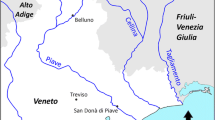Summary
Finite Element Study of the Nevis Bluff (New Zealand) Rock Slope Failure
In June 1975, part of the Nevis Bluff rock slope failed along State Highway 6 in the South Island of New Zealand. The slope is near the bottom of the Kawarau River valley, which has been deeply entrenched in chlorite schist rocks. The detailed geology of the slope, and the mechanical properties of the rocks comprising the slope are described. For the purposes of finite element modelling, the schist was assumed to be a transversely isotropic material with four independent deformability parameters. A two dimensional finite element program was used to establish the regional state of stress, the results from which were then used in a larger scale model of the rock slope. The results of finite element analyses suggested that slope failure occurred by flexural toppling, where continuous columns broke in flexure as they slid along schistosity surfaces. Flexural cracking was then responsible for propagating the plane along which sliding occurred. When the shear strength available along this plane was exceeded by shear stresses, the slope failed.
Zusammenfassung
Untersuchung des Bruches eines Felshanges des Nevis Bluff (Neuseeland) mit Hilfe der Methode der Finiten Elemente
Im Juni 1975 brach ein Teil des Felshanges von Nevis Bluff entlang der Autobahn 6 auf der Südinsel von Neuseeland. Die Rutschung ereignete sich nahe des Talbodens des Flusses Kawarau, welcher sehr tief in Chloritschiefer eingeschnitten ist. Die detaillierte Geologie dieser Rutschung und die mechanischen Eigenschaften der dabei wirksamen Felspartien werden beschrieben. Im Hinblick auf eine Untersuchung des Rutschvorganges mit Hilfe der Methode der Finiten Elemente wurde das schiefrige Medium als transversal isotropes Medium mit vier voneinander unabhängigen Verformungsparametern angenommen. Für die Ermittlung des primären Spannungszustandes wurde ein zweidimensionales Finite-Elemente-Programm benützt. Die Ergebnisse dieser Untersuchung wurden dann in einem erweiterten Rechenmodell für die Hangrutschung verwendet. Die Ergebnisse der Untersuchung zeigten, daß die Rutschung auf einen Mechanismus ähnlich dem Hakenwerfen zurückzuführen sein dürfte, wobei bei diesem Vorgang durchgehende Platten durch Biegung zum Bruch kamen, als sie auf den Schieferungsflächen abglitten. Biegerisse waren die Ursache für die Ausbildung einer durchgehenden Gleitfläche. Sobald die Scherfestigkeit in dieser Gleitfläche überschritten wurde, kam der Hang zu Bruch.
Résumé
Étude de la rupture de pente rocheuse de Nevis Bluff par la méthode d'éléments finis
En juin 1975, une partie de la paroi rocheuse de Nevis Bluff, le long de la route nationale 6 en Nouvelle Zélande s'est éffondrée. La pente est près du fond de la vallée de la rivière Kawarau qui s'est profondément encaissée dans des schistes chloritiques. La géologie détaillée de la paroi et les propriétés mécaniques des roches constitutives sont décrites. Pour la modélisation par éléments finis, le schiste a été supposé se comporter comme un matériau orthotrope avec quatre paramètres de déformation. L'utilisation d'un programme d'éléments finis bidimensionnels a permis d'établir l'état de contrainte régional qui fut transféré à un modèle de la paroi rocheuse de plus grande échelle. Les résultats de l'analyse par éléments finis suggèrent que la rupture a en lieu par fauchage des couches dans lequel des colonnes continues se fissurent en flexion à mesure qu'elles glissent le long de surfaces de schistosité vers l'ouverture. Les fissures de flexion se sont approfondies jusqu'à former un plan sur lequel le glissement a eu lieu. Quand la résistance au cisaillement le long de ce plan a été dépassée par les contraintes de cisaillement, la paroi s'est éffondrée.
Similar content being viewed by others
References
Brown, I. R.: Slope Stability Study, Nevis Bluff, Central Otago. New Zealand Geological Survey Engineering Geology ReportEG 225 (1975).
Goodman, R. E., Bray, J. W.: Toppling of Rock Slopes. Proc. of Specialty Conference on Rock Engineering for Foundations and Slopes, ASCE (1976).
Hittinger, M., Goodman, R. E.: JTROCK: A Computer Program for Stress Analysis of Two Dimensional, Discontinuous Rock Masses. University of California, Berkeley, Department of Civil Engineering Report No. UCB/GT/78-04 (1978).
Martin, G. R., Millar, P. J.: Joint Strength Characteristic of a Weathered Rock. Proc. of Third Congress, International Society for Rock Mechanics, Denver,2A, 263–270 (1974).
Pinto, J. L.: Deformability of Schistose Rocks. Proc. of Second Congress, International Society for Rock Mechanics, Belgrade, 2–30 (1970).
Wood, B. L.: Geological Map of New Zealand, 1: 250,00,Sheet 22, Wakatipu. Department of Scientific and Industrial Research, Wellington, New Zealand (1962).
Author information
Authors and Affiliations
Additional information
With 16 Figures
Rights and permissions
About this article
Cite this article
Brown, I., Hittinger, M. & Goodman, R. Finite element study of the Nevis Bluff (New Zealand) rock slope failure. Rock Mechanics 12, 231–245 (1980). https://doi.org/10.1007/BF01251027
Received:
Issue Date:
DOI: https://doi.org/10.1007/BF01251027




